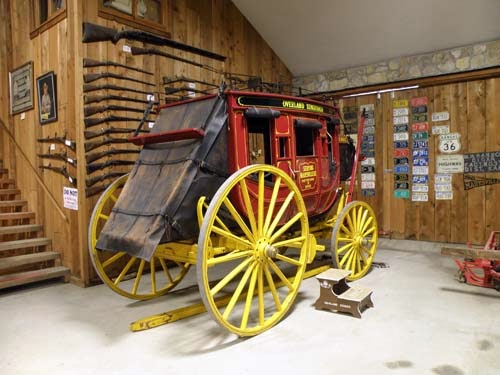Thursday, October 10th
Thursday we drove from Wymore, Nebraska to Topeka, Kansas
and stopped at four trail spots.
The Pony Express Barn in Marysville, Kansas is a stone barn,
built in 1859, that was used as a Pony Express livery stable. The first westbound rider left St. Joseph, Missouri early on the evening of April 3, 1860 and arrived in Marysville at Home Station No. 1 the next morning. Historians differ as to his name, but local tradition says he was Johnny Fry.
The museum consists of the original stable, now the oldest building in Marshall County, and an annex with the museum displays. The displays include information about trails, railroads, and life in 19th century Marysville, Kansas.
We read about the black squirrels found in the town park at Marysville so we stopped
there for lunch. We watched four or five
chasing each other around and running up and down the trees. It was strange to
see totally dark, solid black squirrels. Chloe
liked watching them through the screen door in the trailer. The town protects the black squirrels and I
could just see Chloe pushing open the screen door and managing to catch her
first squirrel, a rare black one. At
home chasing squirrels is one of her favorite pastimes.
Marshall’s Ferry, established in 1852, was one of three
major river crossings on the St. Joseph Road to California. It was on the west side of Marysville,
Kansas. You have to drive a couple of
miles on a dusty dirt road to the park at the site of the ferry. The site is no longer on the river as it was
on an oxbow that was eliminated when the
highway was constructed. There is a full
sized replica of the rope ferry used to carry emigrants, soldiers and
stagecoach travelers across the Blue River.
Eight trails crossed the river
here: the Oregon, Pike’s Peak and Mormon Trails, the St. Joe Road, the
stagecoach, military and Pony Express routes, and the trail followed by Otoe
Indians being sent to the reservation in Oklahoma.
Alcove Spring is between Marysville and Blue Rapids. It is off the highway about six miles on a
good dirt road. Emigrants typically
arrived at Alcove Spring in late spring and often had to camp for several days
waiting for the Big Blue River to go down so they could ford at Independence
Crossing a quarter mile away.
Emigrant
diaries mentioned the cold, clear rushing water, the tall grass and the
wildflowers. The Donner Party camped
here in the spring of 1846 and Sarah Keyes, the Reed family grandmother who was
seventy years old , blind and deaf died and was buried here. When Patty Reed was rescued in the Sierras
the following winter she was found holding a lock of her grandmother’s
hair. A memorial to Sarah Keyes is just
above the meadow across the road from the Alcove Spring parking area.
Chloe and I walked the short distance to the spring. This being early October there was no water
flowing over the top but a small pool was below the overhang.
Names carved into the large slabs of limestone surrounding the spring are still visible.
We were almost stuck at Alcove Spring as our truck began
dying as soon as we started out. Glen
would get it going and it would die again.
We think we got some bad gasoline.
We got back to the paved road and headed towards Topeka for the
night. The truck seemed to run fine the
rest of the day.
We stopped for a short time at Scott Spring another favorite emigrant camping site. It is a roadside pullout with storyboards and a metal sculpture of a wagon.
Whenever we see a wagon we always look for lynch pins. This "sculpture" had lynch pins.
On to Independence tomorrow!













No comments:
Post a Comment